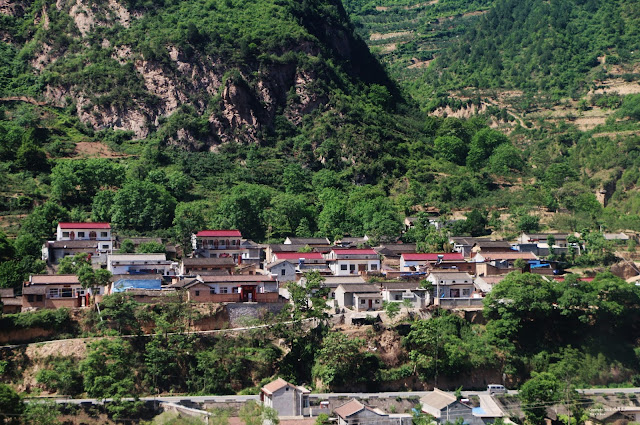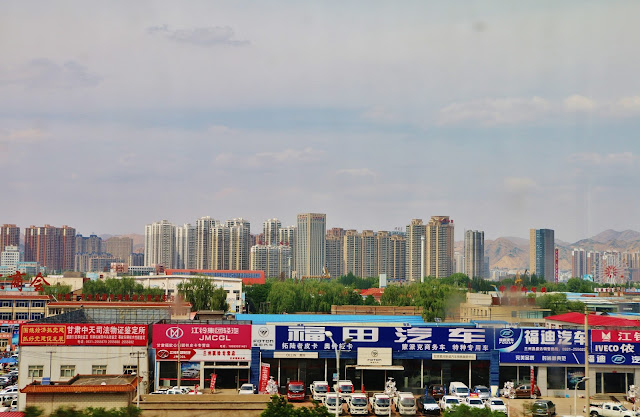Train Ride from Xi’an to Xining – The Beginning of A Journey Crossing The Tibetan Plateau
Episode 1
Episode 1 Episode 2 Episode 3 Episode 4 Episode 5 Episode 6 Episode 7
Episode 8 Episode 9 Episode 10 Episode 11 Episode 12 Episode 13 Episode 14
Episode 15 Episode 16 Episode 17 Episode 18
"Papa, what's on the other side of the mountain?"
"It's mountain"
"And what's after that mountain?"
Jamphel scratched his head. Actually that was a question he didn't even know how to answer. To his son and daughter, he was someone who knew absolutely everything.
"It's another mountain", answered Dolma, the children's mother, "and after that mountain is another mountain. You see, my children, there will always be another mountain after one mountain. It's like reincarnation - it doesn't naturally stop and it will always work in some kind of mysterious cycle."
Jamphel giggled. He looked at the children in each of his arm: they looked very puzzled. Smiling at her husband and the children's reactions, Dolma came to the table, and brought everyone the thukpa she just made.
---------------------------------------------------------------------------------------------
Xi’an in the early morning wasn’t quite like Xi’an during any other time – there were no bustling crowds congesting the sidewalks, nor any signs of the never ending traffic that often went from the old city’s East Gate to the West Gate (and beyond these two gates). I just couldn't stop wondering: where did all of the city’s 8 million residents go? The air was fresh and the sky was clear – one could easily spot the towering peaks of the Qinling Mountains, which was located just south of Xi’an and was the geographical division between the humid, warm Southern China and the arid, cold Northern China.
In the west of the where the Qinling Mountains end is the Tibetan Plateau. Known as “the roof of the world” and “the third pole of earth”, it is the highest region on the planet with some severe climate that can be found in the Arctic / Antarctic region. The Tibetan Plateau is home to many different ethnic groups, including the Tibetans, Nepalese, Bhutanese, Huis, Sherpas, and Hans. It is also the birthplace to Tibetan Buddhism, a school of Buddhism that has become popular way beyond the boundaries of that lonely highland.
The reason why I was up early? I was on my way to the train station to catch a ride to Lhasa, the cultural center of the plateau.
My original plan was to cross the Himalayas from the north side to the south. However due to the 2015 earthquake in Nepal and the travel restrictions in Tibet Autonomous Region imposed by the Chinese government (I'll explain in details in Episode 5), it seemed that 2016 wasn’t a good year to do an overland journey from Xi’an to Kathmandu. The farthest point I reached from Xi’an was Darchen in Tibet’s Burang County, which is located on the extreme west of Tibet and borders India and Nepal. The approximate distance between Xi’an and Darchen by overland was about 4,100 kilometers, or slightly over 2,500 miles.
As the vehicle exited the city wall, the Xi’an Railway Station was in front of my eyes. It was about 6:30 in the morning, but there were only a handful of people there, considering that the station was one of the busiest in China. At 7:28, the train to Xining left the station. Xining was about 10 hours away by train from Xi’an. Tibetan Plateau’s largest city was in fact my first stop of the long journey. The reason why I decided to take the train in the early morning was because in that way I could arrive Xining on the same day.
Looking south, the Qinling Mountains were always in the view until the train entered Gansu Province. The mountains transformed from lush green to dirt yellow, but nonetheless created some jaw dropping sceneries. Along the journey, the train passed through countless tunnels, gorges, and rivers. Occasionally the train would travel through villages, where one could see farmers working together in the fields; the mud houses where generations had lived, fixed, and were ready to be passed down to the next one; and students returning home from school in their uniforms with Young Pioneer’s symbolic red scarves.
During lunch time, I walked into the dining car and ordered myself some food and coffee. Sitting beside my table me were the train’s conductors and the transit police. Some of the conversations they had were quite interesting. At one time, one conductor asked another conductor:
“Have you ever seen those money with Falun Gong’s messages on them?”
The other conductor replied: “Of course I have. I think they are ridiculous and very entertaining.”
The first conductor then said: “I feel like the way they operate is like a mafia. It’s very organized. But unlike mafias, they also have a political agenda behind their actions. To some extent they are also like the Communist Party.”
The transit police, who was a less talkative man, gave some of his feedbacks:
“Now you tell me the differences between Falun Gong, Mafias, and the Communist Party. I don’t think there’s any.”
Everyone in the dining car began to laugh, including myself. I couldn’t believe that these words came out from the mouth of someone who represented the state authority.
In the afternoon, the train reached Lanzhou, a huge city and capital of Gansu located right by the Yellow River – the river which the country sees as the cradle of the Chinese civilization. Like its name suggested, the color of the river was indeed yellow due to the fact that the river contains a huge amount of loose sediments from the Loess Plateau region it passes through. Most of the passengers got off the train, only a few like myself were heading towards Xining.
As the train continued westwards, Tibetan prayer flags and monasteries began to appear. Giant mosques only grew bigger in size as the train sprinted towards Xining. When the train entered the modern Xining Railway Station, the surrounding skyline, which was dominated by Moorish style mosques gave me the impression that I was in somewhere in the Middle East rather than China (Click here to read the article on Xining as a religious crossroad).
I was planning to hail a cab because that would be the easiest and the safest way to reach my hotel. However I noticed that no one was really heading towards the taxi stand. I followed everybody else and eventually found myself at the bus stop. Hui people in Xining were dedicated Muslims who were very proud of their religion and heritage. I knew that I wouldn’t get into any trouble or safety problem when I was with a group of faithful people like the Hui Muslims.
Half an hour later I arrived at my hotel. The hotel reception helped me to get the best room possible and told me about how to stay healthy in a high altitude city like Xining (2,100 meters above sea level). When I inquired about the hotel’s laundry service, the reception told me that a laundry place nearby was significantly cheaper than their hotel service. I was touched by the honesty and the warm hospitality of Xining, despite the fact that it was only my first day there.
I just couldn’t wait to see what else was in Xining the next day.
Episode 1 Episode 2 Episode 3 Episode 4 Episode 5 Episode 6 Episode 7
Episode 8 Episode 9 Episode 10 Episode 11 Episode 12 Episode 13 Episode 14
Episode 15 Episode 16 Episode 17 Episode 18
"Papa, what's on the other side of the mountain?"
"It's mountain"
"And what's after that mountain?"
Jamphel scratched his head. Actually that was a question he didn't even know how to answer. To his son and daughter, he was someone who knew absolutely everything.
"It's another mountain", answered Dolma, the children's mother, "and after that mountain is another mountain. You see, my children, there will always be another mountain after one mountain. It's like reincarnation - it doesn't naturally stop and it will always work in some kind of mysterious cycle."
Jamphel giggled. He looked at the children in each of his arm: they looked very puzzled. Smiling at her husband and the children's reactions, Dolma came to the table, and brought everyone the thukpa she just made.
---------------------------------------------------------------------------------------------
Xi’an in the early morning wasn’t quite like Xi’an during any other time – there were no bustling crowds congesting the sidewalks, nor any signs of the never ending traffic that often went from the old city’s East Gate to the West Gate (and beyond these two gates). I just couldn't stop wondering: where did all of the city’s 8 million residents go? The air was fresh and the sky was clear – one could easily spot the towering peaks of the Qinling Mountains, which was located just south of Xi’an and was the geographical division between the humid, warm Southern China and the arid, cold Northern China.
 |
| Xi'an City Wall In The Morning |
The reason why I was up early? I was on my way to the train station to catch a ride to Lhasa, the cultural center of the plateau.
 |
| Xi'an Railway Station And The City Wall |
 |
| The Farthest Place I Reached: Darchen in Burang County, Ngari Prefecture in Tibet Autonomous Region |
 |
| Qin Mountains Near Wugong County, Xianyang |
 |
| Mountains Near Tianshui, Gansu |
 |
| A Man Fishing |
 |
| A Mining Site |
 |
| A Chinese Village in Gansu |
“Have you ever seen those money with Falun Gong’s messages on them?”
The other conductor replied: “Of course I have. I think they are ridiculous and very entertaining.”
The first conductor then said: “I feel like the way they operate is like a mafia. It’s very organized. But unlike mafias, they also have a political agenda behind their actions. To some extent they are also like the Communist Party.”
The transit police, who was a less talkative man, gave some of his feedbacks:
“Now you tell me the differences between Falun Gong, Mafias, and the Communist Party. I don’t think there’s any.”
Everyone in the dining car began to laugh, including myself. I couldn’t believe that these words came out from the mouth of someone who represented the state authority.
 |
| A Chinese Train Conductor |
 |
| A Valley |
 |
| Geographical Landscapes Along The Train Ride |
 |
| Lanzhou |
 |
| The Old and New Lanzhou |
 |
| A Typical Scenery of the Loess Plateau |
 |
| Infrastructure Construction in China |
 |
| A Concession Worker at Lanzhou Station |
 |
| A Passenger On Board A Train to Urumqi |
 |
| A Prayer Flag Pole Near Lanzhou, Gansu |
 |
| A Traditional Hut On A Farmland |
 |
| Mongolian Gers |
 |
| Mosques Under Construction In Qinghai |
 |
| Xining City Center |
 |
| Dashizi in Xining |



Comments
Post a Comment